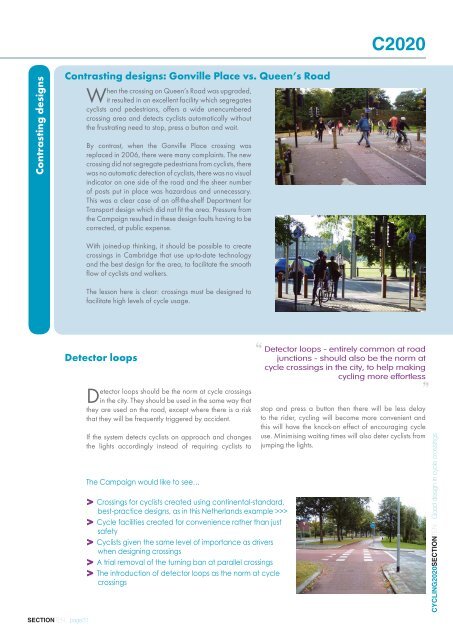Printable PDF version - Cambridge Cycling Campaign
Printable PDF version - Cambridge Cycling Campaign
Printable PDF version - Cambridge Cycling Campaign
- No tags were found...
You also want an ePaper? Increase the reach of your titles
YUMPU automatically turns print PDFs into web optimized ePapers that Google loves.
C2020Contrasting designsContrasting designs: Gonville Place vs. Queen’s RoadWhen the crossing on Queen’s Road was upgraded,it resulted in an excellent facility which segregatescyclists and pedestrians, offers a wide unencumberedcrossing area and detects cyclists automatically withoutthe frustrating need to stop, press a button and wait.By contrast, when the Gonville Place crossing wasreplaced in 2006, there were many complaints. The newcrossing did not segregate pedestrians from cyclists, therewas no automatic detection of cyclists, there was no visualindicator on one side of the road and the sheer numberof posts put in place was hazardous and unnecessary.This was a clear case of an off-the-shelf Department forTransport design which did not fit the area. Pressure fromthe <strong>Campaign</strong> resulted in these design faults having to becorrected, at public expense.With joined-up thinking, it should be possible to createcrossings in <strong>Cambridge</strong> that use up-to-date technologyand the best design for the area, to facilitate the smoothflow of cyclists and walkers.The lesson here is clear: crossings must be designed tofacilitate high levels of cycle usage.Detector loopsDetector loops should be the norm at cycle crossingsin the city. They should be used in the same way thatthey are used on the road, except where there is a riskthat they will be frequently triggered by accident.If the system detects cyclists on approach and changesthe lights accordingly instead of requiring cyclists toThe <strong>Campaign</strong> would like to see…> Crossings for cyclists created using continental-standard,best-practice designs, as in this Netherlands example >>>> Cycle facilities created for convenience rather than justsafety> Cyclists given the same level of importance as driverswhen designing crossings> A trial removal of the turning ban at parallel crossings> The introduction of detector loops as the norm at cyclecrossings“Detector loops - entirely common at roadjunctions - should also be the norm atcycle crossings in the city, to help makingcycling more effortlessstop and press a button then there will be less delayto the rider, cycling will become more convenient andthis will have the knock-on effect of encouraging cycleuse. Minimising waiting times will also deter cyclists fromjumping the lights.“CYCLING2020SECTIONTEN.. Good design in cycle crossingsSECTIONTEN.. page31







